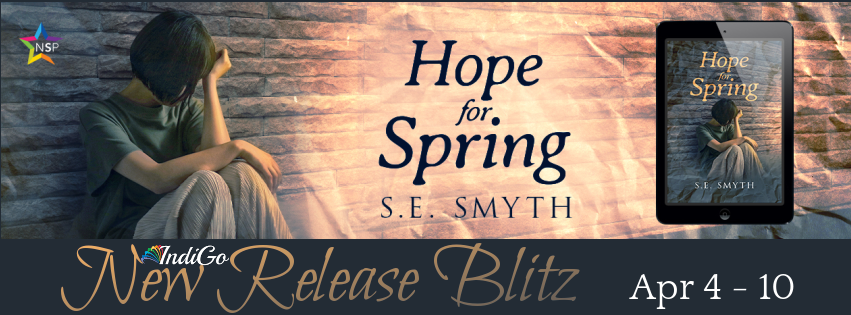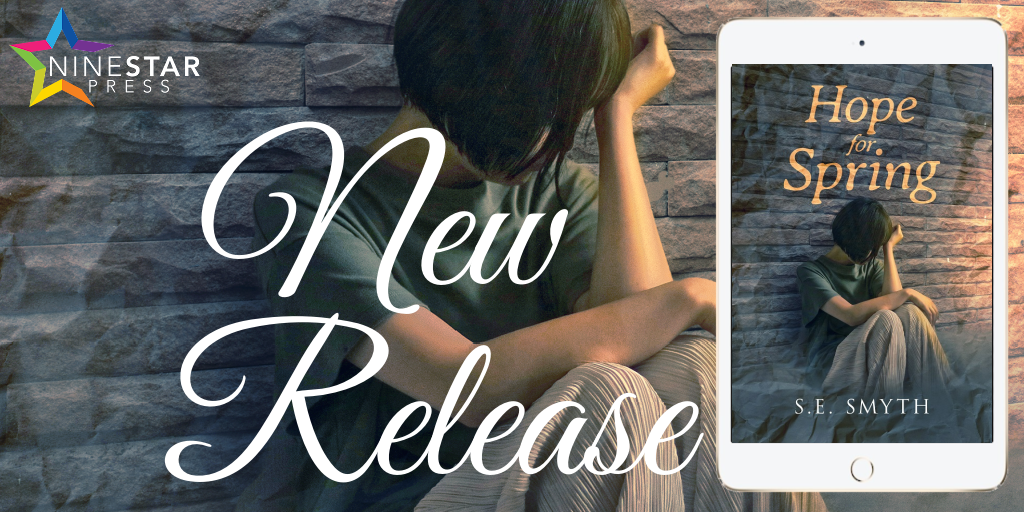Title: Hope for Spring
Author: S.E. Smyth
Publisher: NineStar Press
Release Date: 04/04/2023
Heat Level: 2 – Fade to Black Sex
Pairing: Female/Female
Length: 82100
Genre: Historical, Coming-of-age, Coming out, Criminals, Dark, Friends-to-lovers, Homelessness, Hurt/comfort, Illness/disease, Mental illness, #ownvoices, Road trip, Soulmates, Tear-jerker
Add to Goodreads

Description
Alex struggles with purpose and loneliness. In an act of desperation, betting on fate, she goes out into the streets of California looking for her friend Bob and to get lost in the world herself.
Her journey gives insight into the emotional underbelly of transient life and the unforgiving pulse of mental illness. Both things are daunting, but they are especially lethal when combined.
Hope for Spring
S.E. Smyth © 2023
All Rights Reserved
It’s the fluorescent lighting that makes everyone hate high school, those thick tube bulbs with the probes on either end. The unappealing plastic grates with a tiny bit of depth felt like they would fall off the ceiling and hit me—a hard, plastic impact on my head. I flinched in the light. Germination was difficult. The intellectual crowd didn’t let me weasel in and was my best hope for celebrating difference. Girls wouldn’t talk to me, since I was weird and also liked girls—girls like them.
There were a lot of chilly evenings in our local park. The wooden bench had black metal railings that curved in an Art Nouveau way. The exquisite detailing for a local park extended from bench to internal fence to gate. Lying with my back arched was the best way to recline. The seat had a curve in the seatback that was effective in the sitting position but uncomfortable if you reclined. Sometimes, I thought carefully about the patterns in the detailing. I traced those flourishes on the wall at night in my bedroom, trying my best to be quiet. In the park, I said, “Ok, now you can cry.” My mom never burst into the park, and she never shook me to my senses as she might in my bedroom which was paces down the hall from her. Nobody laughed at my years-long predicament. There wasn’t a person whose life I would interrupt by explaining my sobs, and I already knew people were afraid to hear.
I cried here. I held the emotion in all day or week and painfully blocked; I’d need a release. Buzz. The alarm would go off. “It’s time for your regularly scheduled deep cry,” my internal loudspeaker hollered, satisfied. Time in the park was a release. In between the gasps for breaths, I tried to figure out what to do with myself, and I had the power to change my situation. I never got to how to get through the next week without another nauseous stare. Five, ten years down the road stretched much too far.
Now and then, somebody would ride a bike by or pass on the other side of the park. I would straighten up and calm myself. No one would ever come over, even if they suspected my sadness. Who would do that?
I walked down the hallway on a thirty-year-old asbestos tile floor lurching toward the lunchroom. My worn sneakers slid along, foot then foot, on the smooth surface slick with dust. The individual floor squares were grayish green underneath a coating of haze and furious streaks of use. Nothing screams foul play like a school lunchroom. It wasn’t easy to go near it, mostly because asking to sit with other students was distressing and embarrassing. The cafeteria was avoided as things go it was a big bubble, and I would bounce off. The quarantine was a fifty-foot radius. The last reason was the food was disgusting. All were equally convincing arguments to avoid the location.
I grabbed an oatmeal cream pie or a bag of popcorn when I burst through the bubble and left intersecting with a few other avoiders who steered clear of the lunchroom. I was safe enough to them I guessed, at least in a few respects. If we were rejects, at least we were rejects together. They all had different opinions it seemed, minute to minute. I was still aware of independence and what it meant to me, the ability to choose. No matter how tragic anyone saw my condition, I avoided the idea of long-term care, of hospitals. A person, ten times as crazy, would run rather than submit. It was easier to keep a distance from anyone who evaluates, regardless of age. For instance, there are some people you don’t get into a car with, solely being you can tell their driving is going to be unpredictable and erratic. Sometimes that involves Coke-bottle glasses, but not always.
Practicing self-care included watching movies in front of a box. At the changing of seasons, when the air conditioner hadn’t turned off, or the heat hadn’t yet turned on, there was only a slight discomfort. The classic films I watched at home built an unnecessary, unusable repertoire in many ways. A story in a box is just that. Something that unfolds in the quiet of your room, a cast and plot unfolding for only you. I thought, “Who needed frothy post film arguments to keep their lives afloat, really?” What’s best unspoken in the film is the most capturing. It gets ruined if you divert your attention to popular critical topics.
Photography is a solitary activity. There’s no need for dependence on anyone else. I took my camera everywhere. I went and stared at the world. Everything outside boiled inside me. I had deep sadness, but I did not know the extent of possible depression. I had one thing that gave me the smallest bit of light. I warmed beside it as often as possible. I had a solo career, and that was fine with me. It’s distracting if someone else is there. Bob hung around sometimes, but the extra space mattered. In a way, I decided if that was what I was going to do with my life, I might as well get used to being alone.
I was good at it, and I believed in myself so much I took on multiple student loans. Even if only a shred of hope existed, there was still a possibility. I made myself confident with photography, a true and bold passion. I bet on black, and I went to college with the same types of dreams as everyone else.
Purchase
NineStar Press | Books2Read
Amazon
S.E. Smyth is a versatile author putting words into the world. The stories she tells are never exactly how they happened. Elusive as she proclaims she is, you can usually find her nose buried in primary sources plotting a story. Despite persisting historical references, she wholeheartedly believes she lives in the present.
She resides in a smaller sort of town in Pennsylvania, carries heavy things for her wife, rubs cat bellies, and can often be seen taking brisk walks. The household is certain there is something odd going on. She and her wife travel when the air is right looking for antique stores, bike trails, and the perfect beach. S.E. rises unnecessarily early and usually falls asleep by 9 p.m.
Website | Facebook | Twitter
One lucky winner will receive a $50.00 NineStar Press Gift Code!






